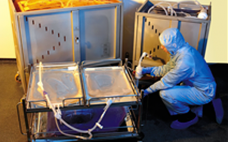As the adoption and maturation of single-use technologies continues to evolve, many end-users are looking for single-use suppliers to standardize products, materials, and equipment in order to improve efficiency and lower costs. An expert group of industry suppliers discusses the pros/cons and differing expectation surrounding this trend.
Upstream Processing
Using the XS Toolbox to Optimize Strain Design and Development for Efficient Microbial GMP Production
No single strain or vector is capable of being the best expression option for all types of biopharmaceuticals. The XS System™ ultimately decreases the time of strain screening and design to enable the fast creation of a valuable production strain and efficient cGMP process.
Bioreactor Design and Bioprocess Controls for Industrialized Cell Processing
It’s official: The “Age of Cell Therapy” has arrived. A robust pipeline of cell therapies, with increasing numbers of both early- and late-stage clinical trials as well as FDA-approved commercial products that have entered the market already, strongly indicates that the cell therapy industry is poised to emerge as a distinct healthcare sector (1). Renewed investor interest and recent activity among major pharmaceutical companies suggest that this industry will rapidly develop the capability and capacity to be a highly competitive,…
A Decade of Bioreactor and Upstream Technologies
A high-quality product begins with efficient upstream process equipment. Ten years ago, manufacturers were still warming up to single-use bioreactors, which were mainly rocking-bag–based solutions. The benefits relating to cleaning and validation were clear, but their use as bioreactor vessels was still new, and stainless steel systems up to 20,000 L in scale were still needed. Today’s facilities are a hybrid of sophisticated single-use components and stainless steel equipment, the mechanisms of both having undergone improvement during the past decade.…
Vertical Integration of Disposables in Biopharmaceutical Drug Substance Manufacturing
Single-use (disposable) technologies are gaining significant traction in biopharmaceutical manufacturing due to reductions in capital investment for plant construction, lower requirements for cleaning and sterilization, and the advantages of eliminating cross-contamination during multiproduct manufacturing (1,2,3,4). In the early days of disposables, single-use (SU) systems were used only in specific unit operations (5, 6). Recently, however, options have become more widely available throughout drug-substance manufacturing (7,8,9,10). Companies now focus on selecting the right SU technology from an array of…
A Decade of Microbial Fermentation
Microorganisms play a vital role in modern life — with applications ranging from wine fermentation to biofuel production to solutions for complex mathematical problems (1). During the past decade, microbial fermentation for protein production reached a higher level of sophistication and wider adoption. When BPI was first published in 2003, the physical and biological characteristics of many microbial cells and the attributes of their fermentation processes were well known. Nonetheless, the economic environment at that time created immense pressure on…
A Decade of Animal Cell Culture
Eukaryotic cells are fragile and finicky, requiring very specific culture conditions and nutrients to survive, grow, and be productive in an ex vivo environment. Even so, they have become vital to the biopharmaceutical industry’s ability to make complex biological products — overtaking yeast as a production system around 1990 and surpassing bacteria in the number of associated product approvals five years later (1). Since then, they have become even more useful, expanding their reach into the vaccine world. Mammalian cell…
Rapid Development of Chemically Defined Media and Feeds through Replacement of Basal Hydrolysates
Protein hydrolysates are widely used in mammalian cell culture to improve cell growth and recombinant protein production. However, use of the hydrolysates can lead to significant process variability, due to the limited control of their source and final composition during manufacturing. On the other hand, development of chemically defined media and feeds requires a tremendous amount of work, including comprehensive library screening and spent media analysis.
In this educational webcast, Dr. Hao Chen, Associate Principal Scientist, BioProcess Development at Merck, describes a rapid method for developing chemically defined media and feeds for Chinese hamster ovary (CHO) cell lines from existing proprietary media and feeds by the replacement of basal protein hydrolysates with novel supplements. In the case studies presented, Dr. Chen shows that after two rounds of optimization, the protein hydrolysate was successfully replaced. The resulting cell growth, protein productivity, and product quality were similar in the chemically defined and original media. The entire development process was completed within six weeks.
The Maturation of Single-Use Applications
“Learn from yesterday, live for today, hope for tomorrow. The important thing is not to stop questioning.” —Albert Einstein Single-use systems (SUSs) have been treated as novel technologies for some time. I have spent much of the past 10 years introducing clients to SUSs and integrating them into conventional processes. They are part of the biopharmaceutical development and production landscape and a mature, integrated option for bioprocessing. The value of SUS integration is soundly substantiated: reduced cross-contamination risk…
Designing the Ideal Bioreactor with Single-Use Technology
Bioprocessing companies are hoping for a brighter future in biologics manufacturing that will include ever-higher titers of vaccines and therapeutic proteins grown in cell culture. It would also facilitate bioprocess operations without the recurring challenges that stem from process scale-up and human error. Moreover, that future would also comply with increasingly stringent regulatory and current good manufacturing practice (CGMP) requirements while providing better cost controls than we see today. How far away is this future? Perhaps not too…



